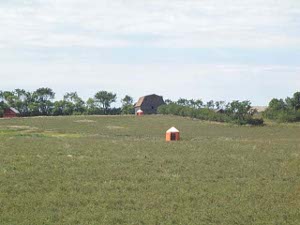 Shetland sheep
Shetland sheep
The skies cleared on Sunday, encouraging us to take a drive to see some sheep. Regina rises from the flat surrounding prairies without any forests or mountains to blunt the view, so even a few miles away the skyline (of the city and the adjacent potash mine and some grain elevators) looks clear and imposing. But immediately upon leaving the city, farm and ranch land begins.
 Shetland sheep
Shetland sheep
The Rose Farm is the project of two schoolteachers - she taught elementary school, he is teaching his last year of high school shop. This would appear to be an excellent background for raising sheep!
We learned that the registered Canadian Shetland sheep are all descended from two flocks originally imported from Scotland. The Rose Shetland sheep come in several colors, from a light grey to rich brown and black. Their wool, sheared each March and spun on the farm, is soft and sturdy in natural colors.
We were especially interested in the Katahdin sheep, because one of our new found cousins - Nancy - breeds Katahdins on her Missouri farm. The Katahdins have long tails and shed their hair coats every year, so they are raised for meat and not wool. As travelers, we find it difficult to get any meats other than beef, pork, and chicken in a restaurant. When we were kids, we were more likely to find lamb on the menu.
On the Rose Farm the flocks are guarded by a couple of donkeys, a couple of llamas, and a large white dog named Emma. Emma is a Maremma - a breed of dog raised to guard farm animals. Emma has a thick coat of white fur which looks admirable for the Saskatchewan winters!
The Provincial art museum in Regina is hosting a travelling exhibit of paintings from World Wars I and II. Canadian artists were assigned to document different aspects of the Canadian military participation. The Canadian Parliament refused to spend millions for an exhibition hall, and so most of the paintings have been in storage, some for 75 years!
 Motherwel homestead
Motherwel homestead
The works, especially those from the first World War, are extremely moving, dark and muddy with emphasis on the destroyed trees and torn ground of the trench warfare. Somehow the paintings convey more emotion than most documentary photographs. We were reminded of our visit to the Imperial War Museum in London, which also has great war art.
An old folk song has the line, "Ain't gonna study war no more." But it's been our experience that the younger generations in North America have virtually no awareness of the great wars of the twentieth centuries. Their ignorance is more frightening because the world continues to be involved in wars, any one of which could spread out of control. We hope these war paintings continue to be exhibited.
Saskatchewan has four regional Western Development Museums located throughout the province. We travelled to Yorkton to visit one of them. While the big attraction for most of the locals was the vast array of old-fashioned farm tools and machinery, we were intrigued by the eight rooms which peeked into the different immigrant cultures.
Because of the climate, the development of the Canadian prairie into productive farms came a little later than the U. S, and the mix of immigrants was a little different. There were large influxes from Britain, Russia, Ukrainia, Germany, and Scandinavia, even a contingent from Iceland. As is true in every pioneer community, the first wave of settlers had to endure a lot of hardships until the infrastructure was built up. When the free land was used up, the flow of immigrants shifted from the country to the cities.
Immigrants are dreamers, and the museum showed a number of their inventions, including a fully enclosed Comfortractor which looked rather like a  Tents for leafcutter bees
giant sedan. It was too expensive for the times, but definitely a precursor of modern farm equipment.
Tents for leafcutter bees
giant sedan. It was too expensive for the times, but definitely a precursor of modern farm equipment.
Speaking of modern farming, we had been curious about the dayglo orange tents evenly spaced over some of the alfalfa fields. The nice sheep farmer at Rose Farm explained to us that these tents provided shelter for leaf-cutter bees, to ensure a highly controlled pollination. These farmers were raising the alfalfa for seed.
What did we learn about this foray into central Canada? We learned that the great plains push north into southern Canada, providing some of the best wheat farming on the continent. We learned that, because of the short growing season, Canadian farmers are highly susceptible to drought. We learned that north of the farm land there is an unimaginable expanse of cold, sparsely settled forest and lakes and then tundra, and so we have a deeper understanding of why 90% of Canadians live within 100 miles of the U. S. border.
And we learned, not for the first time, that Canadians are a very friendly people, with more sense of social responsibility and less unfettered ambition than their American cousins.